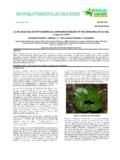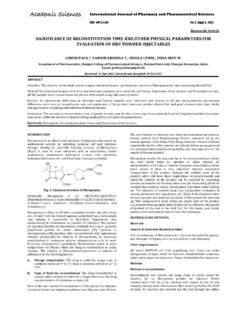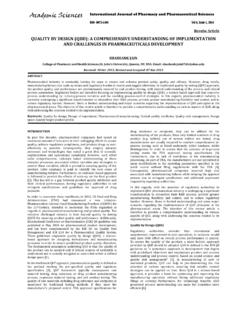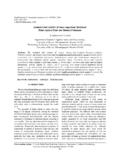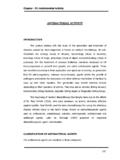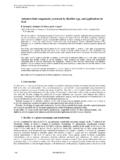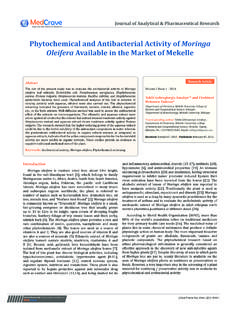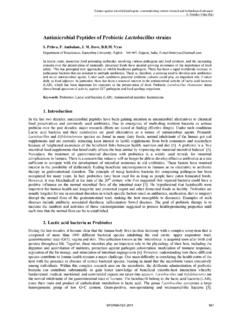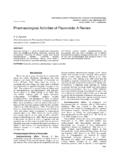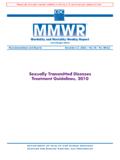Transcription of Evaluation of antimicrobial activity of different …
1 Academic Sciences International Journal of Current Pharmaceutical Research ISSN- 0975-7066 Vol 4, Issue 2, 2012. Research Article Evaluation OF antimicrobial activity OF different SOLVENT EXTRACTS OF. MEDICINAL PLANT: MELIA AZEDARACH L. ANTARA SEN* AND AMLA BATRA. Department of Botany, University of Rajasthan, Jaipur, India. Email: Received: 29 January 2012, Revised and Accepted: 03 March 2012. ABSTRACT. antimicrobial efficiency of Melia azedarach L. a medicinal plants (leaf extracts) were examined using Methanol, Ethanol, Petroleum ether and water, as solvents and tested against eight human pathogens like Bacteria: Bacillus cereus, Staphylococcus aureus, Escherichia coli, Pseudomonas aeruginosa, Fungi: Aspergillus niger, Aspergillus flavus, Fusarium oxisporum, Rhizopus stolonifer using agar well diffusion method and Minimum inhibitory concentration.
2 All the plants showed significant activity against all pathogens, but the alcoholic extract of M. azedarach showed maximum zone of inhibition and minimum inhibitory concentration against all the microorganisms. The minimum zone of inhibition and comparatively greater inhibitory concentration were determined in petroleum ether and aqueous extract of M. azedarach showing less antimicrobial activity against all the experimental strains. The Spectrum of activity observed in the present study may be indicative of the present study alcoholic extracts of these plants could be a possible source to obtain new and effective herbal medicines to treat infections, hence justified the ethnic uses of M.
3 Azedarach against various infectious diseases. Keywords: antimicrobial activity , Melia azedarach L. medicinal plants, Agar well diffusion method , MIC, MBC, MFC. INTRODUCTION in herbal medicines with acceptable therapeutic index for the development of novel drugs12,14. The use of plant and its products has a long history that began with folk medicine and through the years has been incorporated into Melia azedarach L., is traditionally been used as anthelmintic, traditional and allopathic medicine1. Since antiquity, many plants antilithic diuretic, astringent and stomachic14. Various scientific species reported to have pharmacological properties as they are studies reported the anticancer15, antimalarial activity , analgesic and known to posses various secondary metabolites like glycosides, anti-inflammatory activity16.
4 Saponins, flavonoids, steroids, tannins, alkaloids, tirpenes which is therefore, should be utilized to combat the disease causing After scrutiny of published literature showing its medicinal pathogens2,3,4. importance, the present protocol has been outlined regarding the antimicrobial activity on these selected plant using different With the advancement in Science and Technology, remarkable extracts. It is in view of this, that the present research was set up to progress has been made in the field of medicine with the discoveries evaluate the antimicrobial activity of M. azedarach, using different of many natural and synthetic drugs5.
5 Antibiotics are undeniably one plant extractions against some pathogenic bacteria and fungi. of the most important therapeutic discoveries of the 20th century that had effectiveness against serious bacterial infections. However, MATERIAL AND METHODS. only one third of the infectious diseases known have been treated Collection of plant material from these synthetic products6. This is because of the emergence of resistant pathogens that is beyond doubt the consequence of years Mature plants of M. azedarach were used for this study was collected of widespread indiscriminate use, incessant and misuse of from University Botanical Garden, Botany Department, University of antibiotics7,8.
6 Antibiotic resistance has increased substantially in the Rajasthan, different plant Extraction (Methanol, Ethanol, recent years and is posing an ever increasing therapeutic problem. Petroleum Ether and Water) were used for further studies. One of the methods to reduce the resistance to antibiotics is by using Culture and Maintenance of microorganisms antibiotic resistance inhibitors from plants9,10. Plants are known to produce a variety of compounds to protect themselves against a Pure cultures of all experimental bacteria and fungi were obtained variety of pathogens. It is expected that plant extracts showing from the Microbial Type Culture Collection and Gene Bank (MTCC), target sites other than those used by antibiotics will be active Institute of Microbial Technology (IMTECH), Chandigarh.
7 The pure against drug resistant pathogens11. Medicinal plants have been used bacterial cultures were maintained on nutrient agar medium and as traditional treatments for numerous human diseases for fungal culture on potato dextrose agar (PDA) medium. Each thousands of years and in many parts of the world. Hence, bacterial and fungal culture was further maintained by subculturing researchers have recently paid attention to safer phytomedicines regularly on the same medium and stored at 4oC before use in and biologically active compounds isolated from plant species used experiments. Table: For the present study following pure bacterial and fungal cultures were taken: Bacterial culture S.
8 No. Name Type MTCC No. 1 Bacillus cereus Gram positive MTCC4317. 2. Staphylocous aureus Gram positive MTCC3160. 3. Escherichia coli Gram negative MTCC1652. 4. Pseudomonas aeruginosa Gram negative MTCC4676. Table: Fungal cultures S. No. Name MTCC No. 1 Aspergillus niger MTCC282. 2. Aspergillus flavus MTCC2456. 3. Fusarium oxisporum MTCC6659. 4. Rhizopus stolonifer MTCC2591. Sen et al. Int J Curr Pharm Res, Vol 4, Issue 2, 67-73. Preparation of plant extract Preparation of Inoculum In vivo leaves of M. azedarach collected from source plant were Test for antibacterial activity washed for 2-3 times with tap water and finally with distilled water, followed by ethanol wash and then allowed to dry at 50oC for The antibacterial assay was carried out by microdilution method in order to determine the antibacterial activity of compounds tested overnight and finally milled to a coarse powder.
9 100 gm of against the pathogenic bacteria. The bacterial suspensions were powdered material was soxhlet extracted with different solvents adjusted with sterile saline to a concentration of X 107 CFU/ml. like, Ethanol, methanol, petroleum ether and aqueous (12 hour The inocula were prepared and stored at 4 oC until use. Dilutions of each). All the extracts were evaporated in vacuum under reduced the inocula were cultured on solid medium to verify the absence of pressure. All extracts were stored in sterile glass bottles at room contamination and to check the validity of the inoculum. All temperature until screened. experiments were performed in duplicate and repeated three times.
10 Microbiological screening Test for antifungal activity antimicrobial activities of different extracts were evaluated by the In order to investigate the antifungal activity of the extracts, a agar well diffusion method (Murray et al.)17 modified by modified micro dilution technique was used. The fungal spores were (Olurinola,)18 and Minimum inhibitory concentration (MIC)19. washed from the surface of agar plates with sterile saline Media Preapration and Its Sterilization containing Tween 80 (v/v). The spore suspension was adjusted with sterile saline to a concentration of approximately . For agar well diffusion method (Murray et al.)




